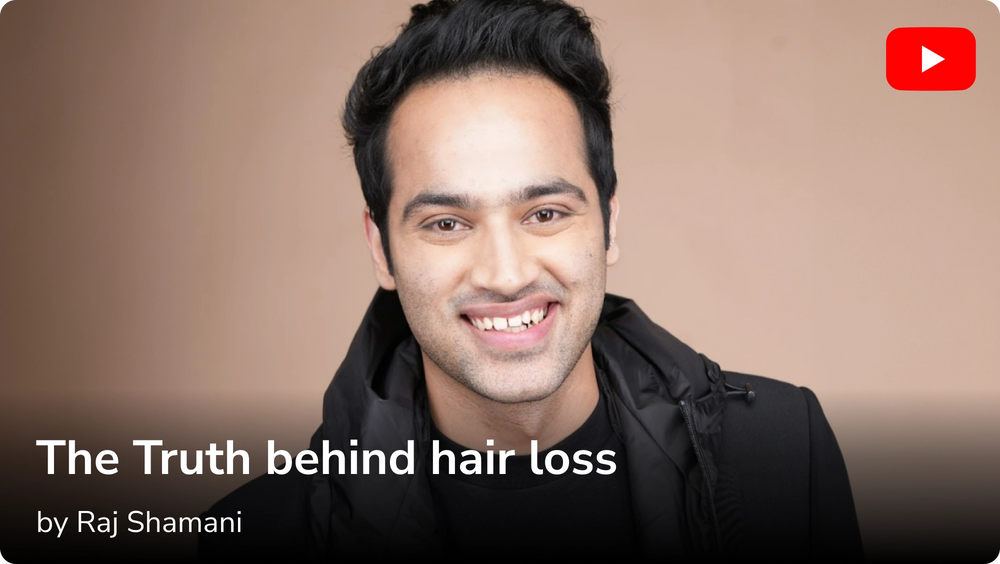The hair is our crowning glory, and when we see a few extra strands on the comb or pillow, it is natural to feel worried. Hair loss is a common phenomenon and occurs in both men and women. Losing around 100 strands of hair in a day is considered normal.
There are different types of hair loss, and it varies in men and women. Identifying the type of hair loss is usually the first step toward effective treatment. Male pattern baldness or androgenic alopecia and telogen effluvium are the two most common types of hair loss seen in men. Let’s understand these two conditions and how telogen effluvium vs male pattern baldness are similar and different.
What is Telogen Effluvium?
Telogen effluvium is a condition characterized by temporary hair loss often triggered by stress, illness, a traumatic event, or medications. A typical example of telogen effluvium is childbirth in women.
What’s important to know is that telogen effluvium often feels like sudden, alarming hair loss, but it's your body’s natural response to internal stressors. It usually begins around two to three months after the triggering event, which is why people often miss the connection. However, once the underlying issue is addressed — whether nutritional, emotional, or medical — hair typically grows back over the next few months.
The lifecycle of hair comprises three phases- anagen (actively growing), catagen (short transitional phase), and the telogen (resting phase). It is the telogen phase that causes the shedding and thinning of hair.
Though telogen effluvium in men causes hair thinning and loss, it is usually temporary and never makes you go bald. It is also reversible as removing or eliminating the stressful event enables the hair to grow back.
What Is The Male Pattern of Baldness?
Unlike telogen effluvium, male pattern baldness doesn’t reverse on its own. Early signs include noticing your hairstyle doesn’t sit the same, or your forehead appears slightly broader over time. Since it is genetically driven, proactive management is key. Treatments can slow the progression, and the sooner you start, the better your chances of retaining existing hair.
Talk of hair loss in men, and the first thing that comes to mind is the male pattern of baldness or androgenic alopecia. The male pattern of baldness is, in fact, the most common type of hair loss seen in men. Men with this condition lose hair above their temples and experience a receding hairline. Simultaneously, they also start losing hair on the top of the head. Together, the hair loss process continues for several years or decades and eventually results in complete baldness.
The male pattern of baldness is hereditary, and men with a family history are more likely to develop the condition than those without it. Though the incidence of this type of hair loss is higher as men grow older, due to changing lifestyles, even younger men are experiencing the male pattern of baldness
Telogen Effluvium Vs Male Pattern Baldness
One of the simplest ways to distinguish the two is to observe the hair fall pattern. Telogen effluvium results in hair falling evenly across the scalp, making hair feel thinner overall. In contrast, male pattern baldness follows a predictable path — receding hairline and thinning at the crown. Also, while telogen effluvium responds to lifestyle and dietary improvements, male pattern baldness requires more targeted medical interventions.
Hair loss can be alarming, especially when you’re unsure if it’s temporary or permanent. Understanding the difference between telogen effluvium and male pattern baldness is crucial. While both conditions lead to visible hair thinning, the root causes and long-term outcomes vary significantly. Early identification can help you take the right action and prevent further damage.
Though both these hair loss conditions result in hair loss, let’s take a look at how they are different:
Causes
-
Telogen Effluvium
As we know, telogen effluvium happens due to a trigger event. Common causes of this condition include:
- Surgery
- Trauma
- Psychological stress
- Sudden weight loss
- Sudden change in diet
- Nutrient deficiencies like vitamin D or iron
- Thyroid problems
- Some medications
Since hair loss due to telogen effluvium in men does not happen until a few months after the trigger, most people cannot relate it to the event.
-
Male Pattern Baldness
The male pattern of baldness occurs due to a complex interplay between genetics and the body’s response to male sex hormones (called androgens). It is a permanent form of hair loss and usually runs in families.
Symptoms of telogen effluvium vs male pattern baldness
In telogen effluvium, you might notice handfuls of hair coming out while showering or combing, but the hair itself looks healthy and there’s no significant irritation. On the other hand, male pattern baldness often includes noticeable miniaturisation of hair — strands become thinner and weaker before falling out. Also, itching or mild inflammation in the crown area can be an early sign of male pattern thinning.
Though both telogen effluvium and male pattern baldness cause hair loss, the symptoms may be slightly different:
-
Telogen Effluvium
You will notice hair loss more when you wash or brush your hair or on your pillowcase. Your hair may start looking slightly limp and thinner around your head.
-
Male Pattern Baldness
In the case of male pattern baldness, men first start losing hair around their temples, and the entire hairline begins to recede, forming an ‘M’ shape. The hair at the top of the head also thins, resulting in complete baldness.
Though called ‘male’ pattern baldness, androgenic alopecia also occurs in women, but the pattern of hair loss is slightly different from that seen in men. Women with androgenic alopecia rarely go bald.
How is Telogen Effluvium Vs Male Pattern Baldness Diagnosed?
Despite similarities between telogen effluvium and male pattern baldness, the right diagnosis helps in effective and safe treatment.
-
Diagnosis For Telogen Effluvium
After taking a complete medical and symptomatic history, the doctor will perform a clinical evaluation of the baldness pattern, how fragile they are or how easily they come off when pulled. The doctor will look for new shorter hair that replaces the fallen hair. In some cases, a biopsy of the strands is conducted to determine if the telogen phase is normal. The entire symptomatic and clinical history will help the doctor determine the cause of hair fall in cases of telogen effluvium.
-
Diagnosis For Male Pattern Baldness
Evaluating the pattern of the hair on the scalp and a familial history will help the doctor determine if your hair loss is a sign of male pattern baldness.
Treatment Of Telogen Effluvium Vs Male Pattern Baldness
Trichologists and dermatologists often use a pull test to differentiate between the two. In telogen effluvium, more than a few strands come loose easily. Additionally, a thorough scalp analysis can reveal if there’s widespread follicle dormancy (common in telogen effluvium) or progressive follicle shrinkage (seen in male pattern baldness). Blood tests might also be advised to check for iron deficiency or thyroid imbalances in telogen effluvium cases.
The treatment for both these hair loss types varies. While male baldness cannot be cured completely, telogen effluvium can be stopped, and new hair growth is encouraged. Few treatment options used include:
-
Minoxidil
-
Anti-androgen
-
Hair transplant
Takeaway
Both telogen effluvium and male pattern baldness are treatable in their own ways, but understanding which condition you have is the first step. If you're unsure, seek expert advice rather than self-medicating or waiting too long. Remember, early intervention can make the difference between hair regrowth and further loss. Trust personalised plans like Traya’s, which consider every aspect of your health, from scalp condition to gut health.
If you are experiencing hair loss, you are indeed not alone! It is essential to understand the difference between male pattern baldness and telogen effluvium in men and seek timely care.
Regardless of hair loss, we at Traya Health believe that hair fall can only be treated by creating a customized solution for the specific type of hair fall the person has. Our doctor-backed solutions are personalized for individual patients as we believe that the one-size-fits-all approach cannot work for hair loss.
Need help treating your hair loss? Visit our experts for more information and effective treatment today!
FAQs
Can Telogen Effluvium Look Like Male Pattern Baldness?
Though the causes of telogen effluvium and male pattern baldness are different, these conditions look alike as they cause hair loss. However, only on careful diagnosis does one realise that they cause a different pattern of hair loss.
How Can You Tell The Difference Between Androgenic Alopecia And Telogen Effluvium?
There are several differences between telogen effluvium and androgenic alopecia:
Telogen effluvium causes temporary hair loss, while androgenic alopecia causes permanent hair loss.
While hair loss is diffuse in telogen effluvium, the pattern of hair loss differs among people with androgenic alopecia as it is genetically driven.
Telogen effluvium usually occurs suddenly in response to a stressful event, whereas androgenic alopecia usually develops over a few years or decades.
Telogen effluvium can occur in men of all ages, whereas androgenic alopecia usually affects middle-aged men.
Does Telogen Effluvium Speed Up Male Pattern Baldness?
Though telogen effluvium does not cause permanent hair loss like male pattern baldness, repeated cycles of telogen effluvium can speed up its onset in people genetically predisposed to it.
How do I Know If I Have Telogen Effluvium?
The most apparent sign of telogen effluvium is hair loss. While most of us lose around 100 hairs daily, you may have telogen effluvium if you notice more hair on your pillow, bathroom floor or comb. People with telogen effluvium tend to lose over 300 strands of hair daily.
Can telogen effluvium and male pattern baldness happen together?
Yes, it’s possible. If someone with a genetic tendency towards male pattern baldness experiences a severe stressor, telogen effluvium can temporarily accelerate hair loss. That’s why understanding both conditions and their interplay is important.
How long does it take to recover from telogen effluvium?
Most people see improvement within 3 to 6 months once the trigger is managed. Full regrowth can take up to 9 months, depending on individual health factors.
Are there early signs before visible thinning starts?
Absolutely. Increased hair on your pillow or clogging in the shower drain can be early warning signs. Scalp sensitivity or seeing thinner strands are also indicators worth paying attention to.
Sources:




















